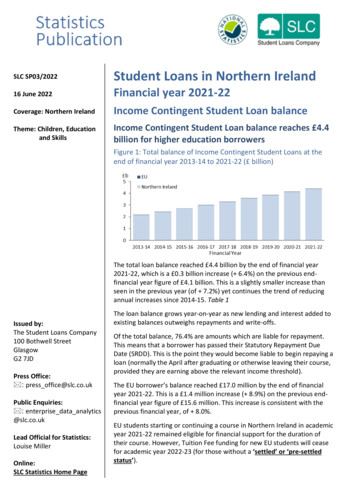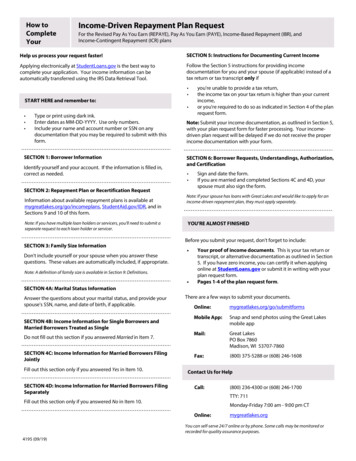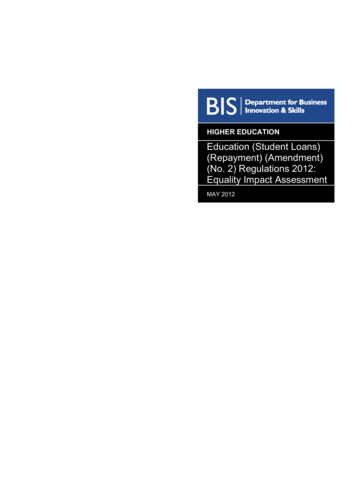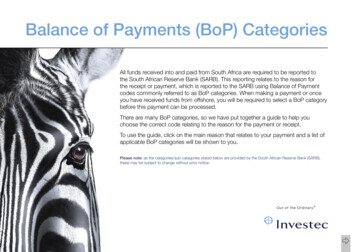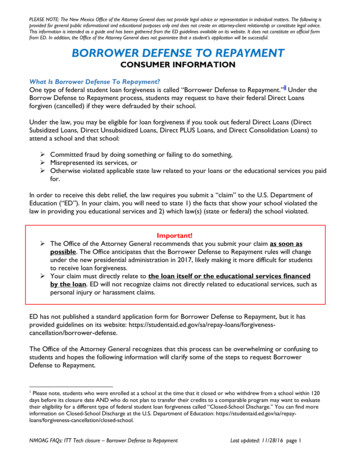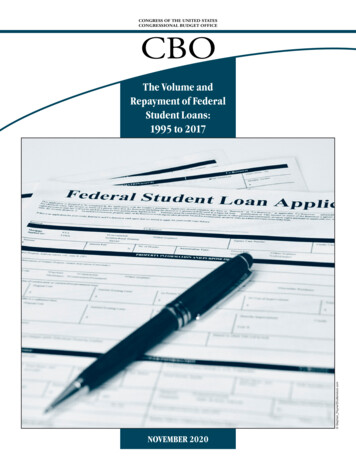
Transcription
CONGRESS OF THE UNITED STATESCONGRESSIONAL BUDGET OFFICE Stephen Payne/Shutterstock.comThe Volume andRepayment of FederalStudent Loans:1995 to 2017NOVEMBER 2020
At a GlanceBetween 1995 and 2017, the balance of outstanding federal student loan debtincreased more than sevenfold, from 187 billion to 1.4 trillion (in 2017dollars). In this report, the Congressional Budget Office examines factors thatcontributed to that growth, including changes to student loan policies andhow they affected borrowing and repayment: Increases in the Number of Borrowers and the Average Size of Loans. Thenumber of new loans issued per year more than doubled, and the size ofthe average loan increased—in part, because large increases in enrollmentoccurred at all types of schools, and the average tuition rose substantially. Changes in the Types of Schools Borrowers Attended. Much of theoverall increase in borrowing occurred because the share of borrowers whoattended for-profit schools increased substantially. Students who attendedfor-profit schools were more likely to leave school without completing theirprograms and to fare worse in the job market than students who attendedother types of schools; they were also more likely to default on their loans. Increases in Defaults and Participation in Income-Driven RepaymentPlans. The incidence of default and participation in income-drivenrepayment plans, which limit how much borrowers must repay regardlessof how much they borrow, increased over the period. Both of those factorsresulted in larger outstanding student loan balances. Changes in Loan Limits, Interest Rates, and Repayment Plans. Periodicchanges to key parameters of student loan policy, such as borrowing limits,interest rates, and repayment plans, also affected the growth of federalstudent loan debt.www.cbo.gov/publication/56706
ContentsSummary1How Do the Federal Student Loan Programs Work?1Why Has the Volume of Student Loans Grown So Much Over Time?1How Have Changes in Student Loan Policies Affected Borrowing and Default?2Types of Loans and Repayment Plans2Types of Loans3Repayment, Default, and Forgiveness3Growth in the Volume of Federal Student Loans Over Time4Components of Student Loan Debt4BOX 1. DID THE EXPANSION OF THE FEDERAL STUDENT LOAN PROGRAMS LEAD TO INCREASES IN TUITION?78Differences in Borrowing and Repayment at Different Types of SchoolsEffects of Policy Changes on Borrowing and Repayment10Estimating the Effects of Changes in Loan Parameters10Loan Limits11Interest Rates13Repayment Plans and Loan Forgiveness16List of Tables and Figures20About This Document21
NotesUnless this report indicates otherwise, the years referred to are federal fiscal years, whichrun from October 1 to September 30 and are designated by the calendar year in whichthey end. Some years are identified as academic years, which run from July 1 to June 30and are also designated by the calendar year in which they end.All loan amounts are expressed in 2017 dollars, unless otherwise indicated. To convertdollar amounts, the Congressional Budget Office used the price index for personalconsumption expenditures from the Bureau of Economic Analysis.CBO’s main source for historical information on disbursements, balances, and repaymentswas the National Student Loan Data System—the Department of Education’s centraldatabase for administering the federal student loan program. CBO analyzed longitudinaldata for a random 4 percent sample from that data set, drawn at the end of 2017.Accordingly, numbers presented in this report may differ slightly from numbers reportedby the Department of Education that are based on the complete set of administrative data.In addition, although the Department of Education may not provide default rates for thesame specific categories of borrowers that CBO analyzes in this report, CBO’s estimateof the average default rate is several percentage points higher than the default rates theDepartment of Education reports. That is probably the result of differences in the wayCBO and the Department of Education define repayment cohorts.
The Volume and Repayment of FederalStudent Loans: 1995 to 2017SummaryThe volume and number of federal student loans, whichprovide financing to make higher education more accessible, have grown over the past few decades. In 2017,the most recent year for which detailed informationwas available, 96 billion in new federal student loanswas disbursed to 8.6 million students, compared with 36 billion (in 2017 dollars) disbursed to 4.1 millionstudents in 1995.1 Between 1995 and 2017, the balanceof outstanding federal student loan debt increased morethan sevenfold, from 187 billion to 1.4 trillion (in2017 dollars).In this report, the Congressional Budget Office examinesthe factors that contributed to the growth in the volumeof student loans and the effects of changes to studentloan policy on borrowing and repayment. Because thereport focuses on the period between 1995 and 2017,it does not cover the effects of the Coronavirus Aid,Relief, and Economic Security (CARES) Act, which wasenacted on March 27, 2020.2How Do the Federal Student Loan Programs Work?Between 1995 and 2017, students could borrow throughtwo major federal student loan programs, the FederalFamily Education Loan (FFEL) program, which guaranteed loans issued by banks and other lenders through2010, and the William D. Ford Federal Direct Loanprogram, through which the federal government hasissued loans directly since 1994. The two programsoperated in parallel through 2010, either guaranteeingor issuing loans to students under nearly identical termsand conditions.1. In 2019, the Department of Education disbursed 88 billion (in2017 dollars) in new student loans.2. Several provisions of the CARES Act directly affected federalstudent loans held by the Department of Education. Oneprovision temporarily suspended required payments throughSeptember 30, 2020. Another provision waived interest accrualon outstanding loans during that period.The direct loan program continues to offer various typesof loans and repayment plans. Loans are limited to amaximum amount (which differs by type of loan) andare extended at an interest rate specific to loan type andyear. After borrowers finish their schooling, they repaytheir loans according to one of the available repaymentplans. Required monthly payments are determined bythe amount borrowed, the interest rate, and the repayment plan. Borrowers who consistently fail to makethe required payments are considered to have defaultedon their loans, at which point the government or loanprovider can try to recover the owed funds through othermeans, such as by garnishing wages. Under certain repayment plans, qualified borrowers can receive forgivenessof their remaining loan balance after a specific amount oftime—10, 20, or 25 years.Why Has the Volume of Student Loans GrownSo Much Over Time?The volume of student loans has grown because thenumber of borrowers increased, the average amount theyborrowed increased, and the rate at which they repaidtheir loans slowed. Certain parameters of the studentloans—in particular, borrowing limits, interest rates, andrepayment plans—changed over time, which affectedborrowing and repayment, but the largest drivers ofthat growth were factors outside of policymakers’ directcontrol. For example, total enrollment in postsecondaryschooling and the average cost of tuition both increasedsubstantially between 1995 and 2017.Much of the overall increase in borrowing was the resultof a disproportionate increase in the number of studentswho borrowed to attend for-profit schools. Total borrowing to attend for-profit schools increased substantially,from 9 percent of total student loan disbursements in1995 to 14 percent in 2017. (For undergraduate studentswho borrowed to attend for-profit schools, the sharegrew from 11 percent to 16 percent; for graduate students, it grew from 2 percent to 12 percent.) Moreover,students who attended for-profit schools were more
2 The Volume and Repayment of Federal Student Loans: 1995 to 2017likely to leave school without completing their programsand to fare worse in the job market than students whoattended other types of schools; they were also morelikely to default on their loans.How Have Changes in Student Loan Policies AffectedBorrowing and Default?The parameters of federal student loans available toborrowers have changed periodically, and those changeshave affected trends in borrowing and default. Between1995 and 2017, policymakers introduced new types ofloans and repayment plans (some of which allow for loanforgiveness after a certain time) and adjusted the parameters of existing loan types and repayment plans. Thisreport focuses on changes in loan parameters that aremost relevant to borrowers—borrowing limits, interestrates, and repayment plans—and the consequences ofthose changes on borrowing and default. Borrowing Limits. Federal student loans are subjectto borrowing limits. All loans are limited by thestudent’s expected cost of attending a school,but most loans have more stringent annual andlifetime borrowing limits. For example, since 2009,dependent undergraduate students have not beenallowed to borrow more than 31,000 in federalstudent loans for all of their undergraduate schooling.Borrowers have responded to those loan limits; whenthe limits increased, they tended to borrow more,which also increased their required monthly payment.After accounting for the borrowers’ and schools’characteristics, CBO found that larger monthlypayments were associated with a slightly increasedlikelihood of default. Interest Rates. The interest rates on federal studentloans varied considerably between 1995 and 2017.Until 2006, loans were issued with variable interestrates, which were indexed to a market interest rateand changed in step with that market rate fromyear to year. After 2006, loans were issued withfixed interest rates, which were set in the year ofdisbursement and then remained constant for the lifeof the loan.Interest rates have had a small effect on the amountborrowed by graduate students, who were lessrestricted by borrowing limits than undergraduates.Higher rates were associated with a slight reduction inNovember 2020the amount of borrowing; lower rates were associatedwith a slight increase. For example, interest rateson student loans were lower during academic years2014 to 2017 than they were from 2007 to 2013,slightly boosting graduate borrowing. Undergraduateborrowers did not appear to be sensitive to interestrates. After the borrowers’ and schools’ characteristics(such as the type or academic level of the schoolattended) were accounted for, higher monthlypayments—which can result from higher interestrates—were associated with slightly higher ratesof default. Repayment Plans. A borrower’s repayment plan,along with the amount borrowed and the interestrate, determines the monthly payment required onthe loan. Under the standard repayment plan, loansare repaid over 10 years. A variety of alternativerepayment plans are available. Some of those plansextend the repayment period to 25 or 30 years;others, called income-driven repayment (IDR) plans,tie required payments to borrowers’ incomes andprovide loan forgiveness after a certain period. In thefirst few years after borrowers enter repayment, therequired payments under IDR plans are often toosmall to cover the interest that accrues on the loan,which contributed to rising levels of debt.CBO found that repayment plans that lowered aborrower’s monthly payments tended to decreasethe incidence of default. Because borrowers selectrepayment plans after deciding how much to borrow,CBO did not estimate the effects of repayment planson the amount students borrowed.Types of Loans and Repayment PlansThere have been two major federal student loan programs. The first was the Federal Family Education Loanprogram, which guaranteed loans issued by banks andnonprofit lenders from 1965 to 2010. In 1994, theCongress established the William D. Ford Federal DirectLoan program, which issued student loans directlywith funds provided by the Treasury. The two programsoperated in parallel through academic year 2010, eitherguaranteeing or issuing loans to students under nearlyidentical terms and offering a variety of loan types andrepayment options. Federal student loans generally haveterms that are more favorable to borrowers than loansoffered by private lenders.
November 2020The Volume and Repayment of Federal Student Loans: 1995 to 2017The Health Care and Education Reconciliation Act of2010 eliminated new FFEL loans. In its last year, theFFEL program guaranteed 80 percent of the new loansdisbursed and accounted for about 70 percent of totaloutstanding balances. Since then, all new federal studentloans have been made through the direct loan program.3In 2020, direct loans accounted for about 80 percent ofthe outstanding loan balance.unsubsidized Stafford loans, accrue interest whilethe student is in school. Unlike Stafford loans,PLUS loans are limited only by the student’s cost ofattending a school. They accounted for 24 percent ofthe total volume (in dollars) of federal student loansdisbursed in 2017.Types of LoansThe direct loan program offers three types of loans: subsidized Stafford loans, unsubsidized Stafford loans, andPLUS loans. The loans vary by eligibility criteria, limitson the maximum size of the loans, and interest rates andrules about how interest accrues: Subsidized Stafford Loans. Available to undergraduatestudents with demonstrated financial need, subsidizedStafford loans have sometimes had lower interestrates than other types of loans. Most significantly,interest does not accrue on those loans during periodsof schooling or when payments are deferred, forexample, during periods of financial hardship ormilitary service. The limits on how much studentscan borrow each academic year and for all their yearsof schooling are relatively low. In 2017, subsidizedStafford loans accounted for 23 percent of the totalvolume (in dollars) of all federal student loansdisbursed and 38 percent of the total volume offederal student loans disbursed to undergraduates. Unsubsidized Stafford Loans. Available to bothundergraduate and graduate students irrespectiveof their financial need, unsubsidized Stafford loansaccrue interest even while the borrower is in school.The borrowing limits are higher for unsubsidizedloans than for subsidized ones. In 2017, unsubsidizedStafford loans accounted for 53 percent of the totalvolume (in dollars) of federal student loans disbursed. PLUS Loans. These loans are available to graduatestudents and the parents of dependent undergraduatestudents. PLUS loans have generally had higherinterest rates than Stafford loans and, like3. For additional information about postsecondary aid, seeCongressional Budget Office, Federal Aid for PostsecondaryStudents (June 2018), www.cbo.gov/publication/53736,and Distribution of Federal Support for Students PursuingHigher Education in 2016 (June 2018), www.cbo.gov/publication/53732.Repayment, Default, and ForgivenessWhen borrowers finish their schooling, they are automatically assigned to the standard repayment plan, whichamortizes the loan principal and accrued interest over a10-year period. Other repayment plans, as well as varioustools for pausing or reducing payments, are available andhave expanded over time. For example, borrowers mayselect a graduated repayment plan or an IDR plan. In agraduated repayment plan, the required monthly payments increase over time, with the expectation that theborrower’s income will also increase over time. In IDRplans, borrowers’ payments are based on their incomesand may be as low as zero if their income falls below acertain threshold. After selecting a plan and beginningrepayment, borrowers may apply for payment defermentor forbearance, which temporarily reduces or pauses theirpayments.4Borrowers who miss a required monthly payment andhave not obtained deferment or forbearance from theirloan servicer are considered to be 30 days delinquent.Borrowers who continue to miss payments and become270 days delinquent are declared by the government tohave defaulted on their loans. When borrowers default,they lose eligibility for further federal aid until thedefault is resolved, and the default is reported to consumer credit reporting agencies.Unlike balances on some other types of loans, the balance on a student loan is usually not discharged whenthe borrower declares bankruptcy. The government or itscontractor is generally required to attempt to recover the4. Deferment and forbearance are temporary periods duringwhich loan payment obligations are suspended. Borrowersmay receive applicable interest subsidies during defermentbut not during forbearance. Deferment may be granted for anumber of reasons, including during periods of schooling ortraining, unemployment, financial hardship, or military service.Forbearance may be granted during periods when borrowersmay be unable to make their required payments. For moreinformation, see Department of Education, Federal Student Aid,“Get Temporary Relief ” (accessed October 13, 2020), https://go.usa.gov/x7TUk.3
4 The Volume and Repayment of Federal Student Loans: 1995 to 2017as teachers in low-income areas for 5 years may havetheir loan balances forgiven. Borrowers in IDR plansmay also qualify for forgiveness after making the requiredpayments for a certain period of time, either 20 or25 years.Figure 1 .Outstanding Federal Student Loan DebtBillions of 2017 te20001995200020052010November 20202015Fiscal YearSource: Congressional Budget Office, using data from the Department ofEducation’s National Student Loan Data System.loan balance through various means, such as by garnishing wages, withholding tax refunds or Social Securitybenefits, or pursuing civil litigation. Typically, throughthose means as well as through voluntary repayment ofdefaulted loans, the government ultimately recovers mostof the remaining balance of loans that defaulted.When borrowers do not pay enough to cover the intereston their loan—for example, when the required paymentin an IDR plan is small, when they receive deferment orforbearance, or when they default—their loan balanceincreases. (For subsidized loans, deferment temporarilypauses interest accrual, so the balances of those loans donot grow during periods of deferment.) Of the borrowerswho entered repayment in the five-year period between2010 and 2014, 56 percent had their balance increaseat some point between the time they entered repaymentand 2017. Of the borrowers whose balance increased,78 percent had received temporary deferment or forbearance, 44 percent had defaulted (including some who hadalso received deferment or forbearance), and 33 percenthad selected an IDR plan.Under certain circumstances, the government forgivessome or all of borrowers’ outstanding loan balances. Forexample, borrowers who work in local, state, or federalgovernment or nonprofit jobs for 10 years or who workGrowth in the Volume of Federal StudentLoans Over TimeThe volume of outstanding federal student loan debtincreased more than sevenfold between 1995 and 2017,from 187 billion to 1.4 trillion in 2017 dollars (seeFigure 1). That growth was the result of an increase inthe number of borrowers, an increase in the averageamount they borrowed, and a decrease in the rate atwhich they repaid outstanding loans.The trends in those variables were related to the typeof school borrowers attended: selective, nonselective,for-profit, or two-year. Among both undergraduateand graduate borrowers, borrowing to attend for-profitschools had the highest percentage increase. Moreover,after finishing their schooling and entering repayment,borrowers who had attended for-profit schools weremore likely to default on their federal student loans thanborrowers who had attended other four-year schools,CBO found.Components of Student Loan DebtThe total amount of student loan debt can be accountedfor by trends in three variables: the number of borrowers,the average amount each borrowed, and the rate at whichthey repaid their loans.Number of Borrowers. More people took out studentloans over time: In 2017, 8.5 million people borrowed,compared with 4.4 million in 1995 (see Figure 2, toppanel). That increase was partially the result of a 36 percent growth in enrollment in institutions of higher education over the period. Increased enrollment was drivenby factors such as population growth, the economicreturn on a college or graduate degree, and generaleconomic conditions.5 Demand for higher education has5. See, for example, Jaison R. Abel and Richard Deitz, “Do theBenefits of College Still Outweigh the Costs?” Current Issuesin Economics and Finance, Federal Reserve Bank of New York,vol. 20, no. 3 (2014), https://tinyurl.com/z2u8xxd. The authorsestablish that the economic return on a bachelor’s degree grewsubstantially between 1995 and 2001, when the return leveledoff, before starting to decline in 2010. That increase in the returnon a college education takes into account the increase in the costof college to students.
November 2020The Volume and Repayment of Federal Student Loans: 1995 to 2017Figure 2 .Components of Total Outstanding Federal Student Loan DebtNumber of Borrowers Who Took Out New LoansMillions of People129The number of peopleGraduatePLUS Loans to Parents who took out loanseach year grew steadilyUndergraduatethrough 152017Fiscal YearThousands of 2017 Dollars30Average Amount BorrowedThe average amountborrowed also grew,Graduateparticularly during the2007–2009 recession andPLUS Loans to Parents partly in relation to risingtuition levels over 2005200720092011201320152017Fiscal YearShare of Borrowers Who Default Within Three YearsPercent403020Undergraduate10PLUS Loans to 1120132015The share of borrowers whodefaulted within three yearsof first beginning repaymentgrew during and after the2007–2009 recession. Thatincrease in defaults alsocontributed to the increasein the total outstandingbalance.2017Repayment CohortSource: Congressional Budget Office, using data from the Department of Education’s National Student Loan Data System.Although the Department of Education does not provide separate default rates for undergraduate and graduate borrowers for each year, CBO’sestimate of the average default rate is several percentage points higher than the default rates the Department of Education reports. That is probablythe result of differences in the way CBO and the Department of Education define repayment cohorts.5
6The Volume and Repayment of Federal Student Loans: 1995 to 2017been cyclical: Enrollment and borrowing both increasedsharply during and shortly after the 2007–2009 recession, when the job market was relatively weak, andthen decreased afterward; the number of new borrowerspeaked at 11.1 million in 2011.6Average Amount Borrowed. Borrowers, on average,borrowed more in 2017 than in 1995 (see Figure 2 onpage 5, middle panel): Among graduate borrowers, the average amountborrowed each year grew by 47 percent, from about 17,400 (in 2017 dollars) in 1995 to 25,700 in2017; For undergraduate borrowers, it grew by 10 percent,or from 6,500 to 7,200, over the same period; and For PLUS loans to parents, the average amountborrowed each year grew more—by 79 percent—from 9,300 in 1995 to 16,600 in 2017.Much of that growth occurred between 2005 and 2009for graduate borrowers and between 2007 and 2009for undergraduate borrowers. Since then, the averageamount borrowed has increased slightly for graduateborrowers and has declined for undergraduate borrowers;it has continued to rise for PLUS loans.Tuition increased substantially between 1995 and 2017,and that increase put upward pressure on borrowing.7(Some research indicates that the expansion of thefederal student loan programs has induced colleges anduniversities to increase tuition. See Box 1.) For example,the average published in-state tuition—also known asthe sticker price—for public, four-year undergraduate institutions increased by 120 percent (adjusted for6. See, for example, Andrew Barr and Sarah Turner, “Out ofWork and Into School: Labor Market Policies and CollegeEnrollment During the Great Recession,” Journal of PublicEconomics, vol. 124 (April 2015), pp. 63–73, https://tinyurl.com/y4ha2qz3, which documents enrollment increases during the2007–2009 recession.7. See Zachary Bleemer and others, Echoes of Rising Tuition inStudents’ Borrowing, Educational Attainment, and Homeownershipin Post-Recession America, Staff Report 820 (Federal Reserve Bankof New York, July 2017), https://ssrn.com/abstract 3003050.In their sample, the increase in public college tuition between2001 and 2009 accounted for a 30 percent increase in the averagestudent debt of 24-year-olds between 2003 and 2011.November 2020inflation) over that period. The average published tuitionfor not-for-profit private institutions increased by 76 percent.8 The effective tuition—the price students paid, onaverage, after accounting for discounts—rose as well,though not as much as the sticker price. Average borrowing per year also increased but by much less, probably inpart because undergraduate borrowers were constrainedby annual loan limits.An increase in borrowing and the resulting increase inthe balance of outstanding federal student loan debtdo not necessarily increase the federal budget deficit orfinancially imperil the borrowers. For example, in itsMarch 2020 baseline budget projections, CBO projectedthat, under current law, student loans issued between2021 and 2030 would result in savings for the government.9 The program is projected to lower the deficitbecause the government has set the interest rates onstudent loans above the rates at which the Treasury borrows to fund the loans. That difference in interest ratescauses the present value—or current dollar amount—ofborrowers’ payments to be greater than the present valueof the cost to the government to disburse the loans (eventhough some borrowers default).In CBO’s March 2020 baseline budget projections, twotypes of loans were estimated to result in costs to thefederal government: subsidized loans and PLUS loansto graduate students. For subsidized loans, interest doesnot accrue while the borrower is in school, which lowersthe amount that borrowers will be required to pay back.For PLUS loans to graduate students, repayments areprojected to be lower because many of the borrowersof those loans select IDR plans, in which the paymentamount is determined by the borrower’s income ratherthan by the amount borrowed. Under those plans,unpaid balances are forgiven once the requirements aremet, which lowers the amount that is expected to be paidback.8. See Trends in College Pricing and Student Aid 2020 (CollegeBoard, 2020), https://tinyurl.com/yxp45soq.9. See Congressional Budget Office, “Student Loan Programs—CBO’s Baseline as of March 6, 2020” (March 2020), https://go.usa.gov/x7KxB (PDF, 524 KB). Budgetary estimates for thestudent loan program are made following procedures specifiedby the Federal Credit Reform Act of 1990. For a more detaileddiscussion of those procedures, see Congressional Budget Office,Income-Driven Repayment Plans for Student Loans: BudgetaryCosts and Policy Options (February 2020), pp. 19–21, 35–36,www.cbo.gov/publication/55968.
November 2020The Volume and Repayment of Federal Student Loans: 1995 to 2017Box 1.Did the Expansion of the Federal Student Loan Programs Lead to Increases in Tuition?As the volume of student loans increased between 1995 and2017, the tuition that colleges charged also increased. Moreover, it was not just the sticker price of tuition that increased;the average tuition that students paid after accounting forstudent aid such as grants and tax credits also rose, althoughat a slower rate.1to which expanding student loan availability contributed tocolleges’ and universities’ ability to charge higher prices for thesame services. To do that, economists studied periods in whichstudents’ or parents’ ability to borrow for school changedsharply.Rising tuition increases the amount that students borrow. Butthe effects may go in the other direction as well: The increasein students’ ability to borrow may have induced colleges toincrease their tuition. The idea that student loan availabilitycauses higher tuition is referred to as the Bennett hypothesis,named after former Secretary of Education William Bennett,who publicly formulated the idea in 1987.For example, David Lucca and coauthors studied the effectsof increases in loan limits for subsidized and unsubsidizedStafford loans in academic years 2008 and 2009 on tuition forundergraduate programs. They estimated that schools accepting students with those types of loans increased their stickerprice tuition between 20 cents and 60 cents for each dollar theloan limits increased and that the net price students paid afteraccounting for discounts also increased.4Various factors have pushed up tuition over time. The costof the services that colleges and universities provide hasincreased, driven in part by increases in the cost of employing faculty and staff. At the same time, support from statesand localities has decreased, which has particularly affectedpublic colleges and universities. During and after the 2007–2009 recession, for example, at those schools the averagefunding per student from state and local governments fell andtuition increased sharply. Later, as that funding increased, thetuition growth rate slowed.2Mahyar Kargar and William Mann studied the tightening, in2011, of eligibility criteria for PLUS loans available to parents ofundergraduate students. Many parents who had been eligible
Student Loans: 1995 to 2017 Summary The volume and number of federal student loans, which provide financing to make higher education more acces-sible, have grown over the past few decades. In 2017, the most recent year for which detailed information was available, 96 billion in new federal student loans


